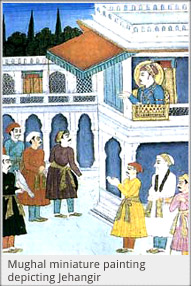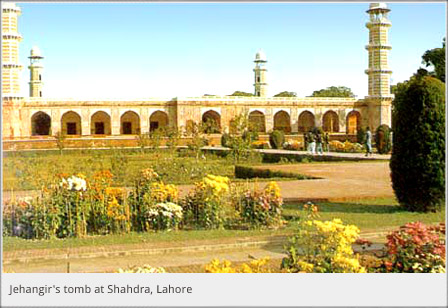Akbar was succeeded by his son, Salim, who took the title of Jehangir, meaning “Conqueror of the World”. He expanded the empire through the addition of Kangra and Kistwar and consolidated the Mughal rule in Bengal. Although many rebellions arose in the empire, especially in Bengal and Mewar, Jehangir was able to suppress them all. Jehangir was renowned for administering impartial justice to his people, irrespective of their religious faith. Around this time, European traders had started coming to India. The English were able to find favor with Jehangir and cultivated him through works of art, of which Jehangir was a connoisseur. The first ambassador to the Mughal court was Sir Thomas Roe. He was able to secure many trading facilities for his countrymen.
 The Mughal rule reached its climax during Jehangir’s reign. In the history of Mughal architecture, Jehangir’s reign marks the period of transition between its two grand phases, namely the phase of Akbar and that of his grandson, Shah Jehan. The most important feature of this period is the substitution of red sandstone with white marble. Jehangir had a deep love of color. The system of pietra dura, i.e. the inlaid mosaic work of precious stones of various shades, gained popularity towards the end of his reign. He was also fond of laying gardens. One of the most famous gardens laid by him was the Shalimar Bagh in Lahore. The Mughal style of art was greatly developed during his reign. The most important feature of the paintings of this era was the decline of the Persian and enhancement of the Indian cultural influence.
The Mughal rule reached its climax during Jehangir’s reign. In the history of Mughal architecture, Jehangir’s reign marks the period of transition between its two grand phases, namely the phase of Akbar and that of his grandson, Shah Jehan. The most important feature of this period is the substitution of red sandstone with white marble. Jehangir had a deep love of color. The system of pietra dura, i.e. the inlaid mosaic work of precious stones of various shades, gained popularity towards the end of his reign. He was also fond of laying gardens. One of the most famous gardens laid by him was the Shalimar Bagh in Lahore. The Mughal style of art was greatly developed during his reign. The most important feature of the paintings of this era was the decline of the Persian and enhancement of the Indian cultural influence.
Mughal paintings lost much of their glamour and refinement after Jehangir’s death in 1627. During the late 17th and 18th centuries this art migrated to regional centers such as in Rajput and Jaipur, where it prospered under the influence of the local culture.

This article was last updated on Sunday, June 01, 2003






